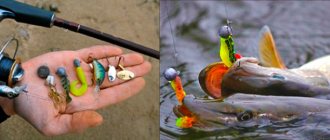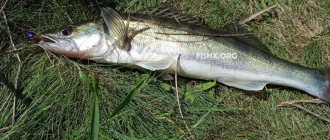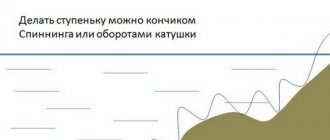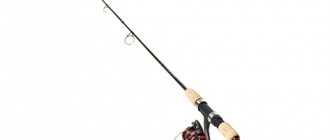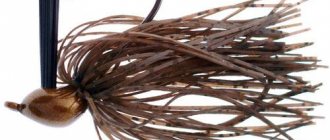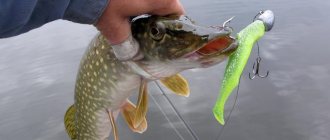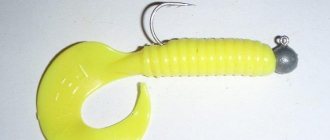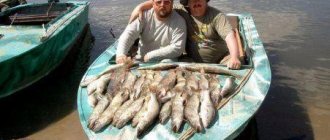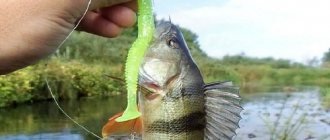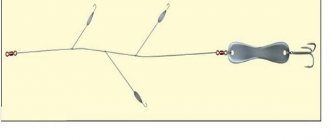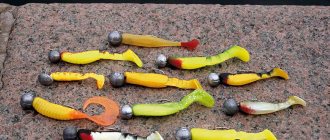For effective jig fishing in the current, you will need the right gear, the choice of which depends on the strength of the current, the depth at the fishing site and the strength of the wind. For example, jig on a river with a medium flow requires the use of sinkers with a weight of 10-40 g and a step of 2 g. Incorrect equipment and incorrect weight of equipment are the main reasons why jig may be ineffective.
On small rivers with weak currents, jig fishing from the shore or from a boat can be equally effective. As for large rivers with medium and strong currents, in such conditions the prospects for fishing from the shore drop significantly.
Due to frequent hooks and limited fishing, it is much more convenient to fish on large and medium-sized rivers from a boat.
Tips for fishing with a jig in the current:
- Use different jig weights in 2 gram increments
- When retrieving, the pause while the bait falls should be 2-3 seconds.
- The thinner the line, the less it will be carried downstream and the further the cast will be.
- In strong currents, you need to avoid forming a large arc of the line, this will allow the bait to fall to the bottom faster.
- Try to fish on the border between the main and reverse currents.
Where to fish
When fishing a deep hole with a jig, you should start from the entrance to it, going downstream 10-15 m. In such relatively small segments they reach the exit from the hole, but if the place is promising and bites have been observed, this section of the reservoir should be fished again along a different trajectory.
The direction of casting is downstream or at an acute angle to it. The smaller the angle, the easier it will be to control the movement of the bait.
Jig casting and retrieving
When, after casting, the bait touches the surface of the water, close the line handle, take out the slack in the line, tilt the rod forward at an angle of about 45 degrees and count the seconds until the sinker reaches the bottom. By recording the amount of time it took for the weight to fall, you can later determine the approximate depth in other places.
After the sinker touches the bottom, we reel in the fishing line a little (literally 2-3 turns) and pause. The bait falls to the bottom again, and then the actions are repeated. In this way, classic step wiring is carried out.
If it is possible to control the retrieval by the sag of the fishing line, keep the spinning rod in line with the fishing line, also observing the tip of the rod. The task will be simplified by using fluorescent braiding, which is much more visible against a dark background.
Features of jig-spinning fishing on the river
Peculiarities of jig spinning fishing on the river
Shore fishing with jig baits on the river, when compared with lake fishing, has differences and its own specifics. If on a lake the only thing that interfered with the usual sensation of driving was the wind, then the current of the river also leaves an important imprint.
Moreover, if the wind on the lake may subside, then we will need to fight the current invariably. Based on this, more stringent requirements are placed on the sensitivity of the rod when river jig fishing. Due to the fairly frequently changing speed of the current across the entire width of the river, jig wiring is often on the verge of perception, since currents of different speeds usually bend the fishing line in the form of a snake, and contact with the bait is also lost. While on the lake the use of monofilament is fully possible, then river fishing forces us to completely switch to braided fishing lines. A significant point that eliminates many troubles is the use of the most sensitive rod and Shcherbakov jig nod. Fishing tactics on a river, as in a still body of water, boils down to searching for edges, depth changes, holes and flooded snags, and other similar places. When fishing from the shore, the best placement of a jig bait is carried out when the cast is performed perpendicular to the river flow, a little higher or a little lower. At the end of the cast, the reel bracket closes if the depth is small, or remains open if the depth is enormous and there is a strong current. If you immediately close the bracket at great depths, the bait will sink to the bottom on a stretched line, very slowly, and touch the bottom much lower downstream than you.
Thus, the most promising section of the bottom in the sector from 90 to 45 degrees to the river flow, where the wiring is perfectly felt, will be lost. In order to expand the working area, it is necessary to cast a little further upstream. This allows the bait to sink to the bottom directly opposite you. After the jig touches the bottom, a simple stepwise retrieve is performed.
Rice. 23-2
Rice. 23-3 In Fig. 23-2 shows the river bank, the river flow, and the fisherman's place. If we cast perpendicularly, then we get two sectors (Fig. 23-3).
Rice. 23-4 In the first sector (Fig. 23-4) the wiring is controlled more optimally, and here it is possible to do the wiring only by rotating the coil.
Rice. 23-5 And in the second sector (Fig. 23-5), the current begins to influence, and we need to switch to wiring with a rod, in other words, combine wiring with a reel and a rod. This way we achieve better bait tracking.
Rice. 23-6
Rice. 23-7 If we use a light head, we can do this. To make the retrieve longer, we do not cast directly in front of us (Fig. 23-6), because while the bait is sinking, it will touch the bottom downstream (Fig. 23-7), the retrieve will begin there, and the sector will be smaller (Fig. 23-7).
Rice. 23-8
Rice. 23-9 Based on this, we throw the bait towards me (Fig. 23-8), it begins to sink, touches the bottom opposite us, and the sector increases (Fig. 23-9). This way we improve the wiring. And in the second sector we start retrieving again with both rod and reel. And so we very effectively fish the river with stepped wiring. At the time when the foam rubber begins to leave the 45-degree sector, the current tries to throw the bait upward. The result of this is a situation where the jig hangs and does not want to sink. Many spinners mistakenly believe that there is a deep hole there, and the weight of their load is not enough to reach the bottom in a strong current. In this situation, it is possible to increase the weight of the load, but then the wiring in the working sector will significantly deteriorate. According to our point of view, the best fight against jig freezing is not to increase the weight of the jig head, but to simply put the line under tension with the reel.
Of course, along with this, the reel must be removed from the brake and rotated in the opposite direction. Edge fishing can be created using several methods. If the edge is located at a great distance from the shore, then after completing several full steps, at the end of a long cast, at a time when the edge has already been passed, it is advisable to easily reel out the fishing line rather than force the jig bait to jump all the way to the shore in shallow water . In reality, the working area will be the edge itself and its immediate surroundings. Based on this, it is the working area that needs to be fished most meticulously. Moreover, it is absolutely necessary to try to cast beyond the far edge, since casting from shallows to depth is most effective. At a time when the edge is located close to the shore, guiding against the current will be quite effective.
Rice. 23-10 Along with this, it is necessary to select a heavier load. He is obliged to mine to the bottom throughout the entire wiring. The cast is made downstream beyond the far edge. The jig must touch the bottom before falling into the depths. Then stepwise wiring is performed. What if the load hangs, in other words, the current does not allow it to lower normally, and it is possible that a little fishing line may be put into tension. The trajectory of the jig will also go straight along the slope of the near edge. This is a very effective wiring, since the jig is in the fish’s field of view for quite a long time. When fishing coastal edges, it is possible to very effectively use jigging bait along the edge, but not against the current, but downstream.
This wiring was originally intended for catching pike perch using large jigs with natural bait and was called “fishing with a walking donk.” The essence of fishing was that the fisherman used a spinning rod to cast a heavy jig, the weight of which reached 15-30 grams, either a dead fish, or a large one, or a live fish was placed on the hook of the jig by the lips, and the jig, along with this jump, moved downwards with the flow. This is a very exciting fishing method. In the late 70s, this was one of the most effective ways to catch pike perch on rivers with great depth and fast currents. So, in order for the bait to move downstream, you need to move the rod all the time to accompany the bait and release the fishing line under tension.
We easily release the line with the reel, in other words, we lift the jig. She has risen, the current begins to carry her, and now we release the line from the reel and lower the rod down. For such fishing, only inertial reels were used. Then the metropolitan spinning player Eliseev also created a similar wiring, but only unnatural bait was already used in it, and he used it very effectively in exactly similar conditions. But, in addition to the fact that the bait can be cast downstream, positioned slightly above the place where the fish stands, it is very effective to fish using a simple spinning reel and casting against the current.
Retrieving in this case is quite easy: pulling the rod, sharply raising the rod up, then the rod goes down, and now we are soon picking up the slack in the line. Along with this, if the cast is made against the current, and the bait is pulled downstream of the river, in other words, the jig jumps along with the current, as if moving towards you, then use heads with the least possible weight. The weight of the heads must be selected based on the fishing conditions, so that the bottom feels great, and the time the jig falls to the bottom is sufficient for the fish to react.
Rice. 23-11 For this kind of fishing, it is very effective to use a jig nod (Fig. 23-11), due to the fact that the current moves towards you, the jig falls, and it is very difficult to track the bottom. And the jig nod allows you to do this with ease. It must be said that in summer the method of feeding bait along the current is the most effective, and it is the best way to catch pike perch. It is also worth emphasizing that step retrieving can be done either with a reel, or with a rod, or with a combination of a reel and a rod.
Rice. 23-12 Heavy jig bait can only be cast with a reel. Medium weight - first with a reel, then with a rod. And it is best to cast a light bait only with the help of pulling with a rod.
Rice. 23-13 Just in this case it will be possible to reach the bottom with a light bait when fishing in the current. Due to the fact that a heavy head falls to the bottom faster, and the bottom is felt better. The lighter the jig head, the more difficult it is to track the bottom. And based on this, by moving the rod forward with the flow, we have better control of the bottom. And the lighter the head, the more seriously we should use wiring using pulls with a rod. It must be stated that an indicator of the class of a jig spinning player is that he can fish with both super-heavy jig heads and extremely light ones. Let us remind you that it is very difficult to fish with extremely light jig heads. If you master fishing with ultra-light jig heads on the river and begin to control the bottom perfectly, your results will be very impressive.
Fishing for pike and pike perch using spinning rods in late autumn
How to choose a sinker weight for a jig
If the current is too strong, there is no sag in the line, and therefore you have to control the wiring only by observing the tip of the rod. In such conditions, the spinning rod can be held at an angle to the horizon or even in a position parallel to the shore.
Relative to the vertical plane, the tip of the rod is held at an acute angle of 45-50 degrees, so that the line comes out of the tulip of the rod at a right angle. This position of the spinning rod will make it easier to track the contact of the bait on the bottom of the reservoir.
The wiring diagram may vary. For example, the following method is considered a classic: 3 turns of the reel, pause, drop the bait for 2-3 seconds and touch the bottom, and then repeat all actions. During such a retrieve, the movement of the bait is a system of smooth jumps at the very bottom of the reservoir.
Another wiring option is this: we sharply raise the spinning rod about 1 meter up and lower it back, picking up the slack in the line using a reel, and then pause for 2-3 seconds. With such actions, the bait rises sharply from the bottom and then smoothly falls back, provoking predators to attack. To achieve the best results, you need to constantly experiment with wiring, without stopping at just one method.
Posting a jig bait
If you think that jig wiring is monotonous, then you are a little mistaken. The number of revolutions, reeling speed, height and sharpness of the jig bait’s separation from the bottom should constantly change.
For example, you are fishing in a place with complex and varied terrain: on release, the bait falls on a dump on the opposite bank, then there is a channel ditch, then a slight rise and a coastal ditch.
In such cases, it is recommended to make a large number of turns with the reel handle at high speed in small places, but it is better to do it differently. Do not spin the reel at breakneck speed, but make no more than three leisurely turns of the reel.
This is necessary in order not to miss the fall into depth. If we make 5-6 revolutions at a fast pace, we will simply miss it.
Further, the jig bait begins to fall from the dump. This can be clearly felt by the sharp increase in the time the jig falls to the bottom.
At this moment, it is better not to make sudden movements with the bait, reduce the number of revolutions to 1-2 and during a pause, release the line using a spinning rod, tilting it towards the water. But the line must nevertheless remain constantly taut, since a fish bite is most likely at this time.
Why do you need to lower the tip of the spinning rod to the water? The answers to this question are quite simple: the jig bait falls along a more vertical trajectory, and changes in relief are determined best this way.
For shore fishing, I use foam fish and small twisters from 2 to 5 inches. In most cases, the optimal twister length is 3 inches.
I use weights weighing from 14 to 52 grams, depending on the strength of the current, depth and required casting distance. Moreover, I use weights from 14 to 32 grams with 3-inch twisters, and heavier ones with 4-5-inch twisters.
And here's what you need to know: Do-it-yourself spinning rod repair
This is necessary so that when using larger and more floating baits, the casting range does not decrease.
Having a leash is strictly required. Otherwise, frequent cuts of bait by pikes are possible. And the braided line suffers a little less when in contact with the edges.
For fishing from the shore you need a long-range jig kit. The minimum length is 2.7, and preferably 3 m. A test from 14 to 60 g will be sufficient in most cases. The minimum reel size according to the Shimano classification is 4000.
Alexey Murugov
When, after casting, the bait touches the surface of the water, close the line handle, take out the slack in the line, tilt the rod forward at an angle of about 45 degrees and count the seconds until the sinker reaches the bottom. By recording the amount of time it took for the weight to fall, you can later determine the approximate depth in other places.
After the sinker touches the bottom, we reel in the fishing line a little (literally 2-3 turns) and pause. The bait falls to the bottom again, and then the actions are repeated. In this way, classic step wiring is carried out.
If it is possible to control the retrieval by the sag of the fishing line, keep the spinning rod in line with the fishing line, also observing the tip of the rod. The task will be simplified by using fluorescent braiding, which is much more visible against a dark background.
If the current is too strong, there is no sag in the line, and therefore you have to control the wiring only by observing the tip of the rod. In such conditions, the spinning rod can be held at an angle to the horizon or even in a position parallel to the shore.
Relative to the vertical plane, the tip of the rod is held at an acute angle of 45-50 degrees, so that the line comes out of the tulip of the rod at a right angle. This position of the spinning rod will make it easier to track the contact of the bait on the bottom of the reservoir.
The wiring diagram may vary. For example, the following method is considered a classic: 3 turns of the reel, pause, drop the bait for 2-3 seconds and touch the bottom, and then repeat all actions. During such a retrieve, the movement of the bait is a system of smooth jumps at the very bottom of the reservoir.
Jig fishing on rivers with weak and medium currents also allows you to use various baits. These can be popular silicone fish, cheap foam fish, spinner baits with front loading and others. The choice of bait rather depends on the preferences of the fisherman himself and their availability.
No less important is the method of mounting baits.
And here's what you need to know: Fishing with potatoes Baiting with potatoes Catching carp with undercooked potatoes
There are three main jig rigs:
- mounting on a jig head,
- silicone offset hook,
- silicone on double hook.
How much your “twister day” on the shore will cost depends greatly on the shape of the jig head. “Stand-up” (analogous to our “vanek-stands” or “boots” - Ed.) is the most successful solution, at least for the wallet.
These types of jig heads are less prone to getting snagged on rocky bottoms.
Thanks to this jig head, we not only have much fewer hooks, but also reduce the number of idle bites. Due to the flattened lower surface, it sits on the bottom while the hook faces upward.
If the pike perch “sweeps” this bait from the bottom, where it was in the resting stage, it is guaranteed to meet the hook. And the spherical jig heads at the bottom fall to one side, and the hook after hooking in this situation will most likely “whistle” past.
River jigs
Jig fishing on rivers with weak and medium currents also allows you to use various baits. These can be popular silicone fish, cheap foam fish, spinner baits with front loading and others. The choice of bait rather depends on the preferences of the fisherman himself and their availability.
No less important is the method of mounting baits.
There are three main jig rigs:
- mounting on a jig head,
- silicone offset hook,
- silicone on double hook.
Determining the bottom topography
If you consistently make 3 turns of the reel, but the time the bait falls suddenly increases by 2-3 seconds, this means that you have found the edge and the sinker is falling down the slope into the hole.
Situations are also possible when the sinker touches the bottom almost not felt, but the bait immediately begins to drag along the bottom, which is signaled by frequent twitching of the rod tip. In such cases, it is necessary to place a load with less weight or change the place to a deeper one. Or you can try to cheat by casting the rig a little lower downstream, so that the latter will tighten the line and the bait will work effectively even with a large sinker.
Features of catching pike perch in spring
Here the approach to finding a place changes, and you have to choose the right bait, and sometimes this is not so easy. And the pike perch itself loves to show its character, abandoning the foundations we are accustomed to.
Summer tactics : in deep water during the day and in shallow water at night; it does not work at all in the spring. In spring, pike perch stays at shallow depths, both day and night. Speaking of shallow depths, we mean 2-6 meters. In the spring, like all fish, it goes to spawn.
In different habitats, at different times, from about mid-April to the end of May. Before spawning, the glutton naturally begins. But it’s not so easy to catch pike perch at this time, since at this time the flood usually begins and the water level rises.
The period of gluttony lasts a maximum of 2 weeks no more. Then the bite suddenly stops, and fishing for pike perch should be postponed until the summer, and there is a ban on spinning and spawning fish ahead.
Regardless of the time of year, be it winter or summer, spring or autumn. Weather plays an important role in catching pike perch...
Catching pike perch from a boat in the spring with silicone baits (Video)
Jig on the reverse current
Sometimes a difficult situation arises when the main strong current passes 50 meters from the shore, and a weaker reverse current flows closer. As a rule, bites occur precisely at their border, where there is often a sharp difference in depth. However, the bait is thrown beyond this boundary, which causes the line to bend: half in one direction, half in the other. For this reason, bait control becomes significantly more difficult.
To simplify the task of fishing with a jig in such conditions, it is necessary to place a load with the calculation of fishing precisely on the main current. The boundary of the streams is thrown only a little, and then the rod is raised high, retrieved along the edge and quickly reeled out the line if there are no bites.
Posting a jig bait
Monofilament fishing line is highly stretchable, so the bait behaves on it like on an elastic band. There is no trace left of the effect that we so need (when the bait reacts without delay to the slightest jerk of our rod). That's why I always have braid on my spool. It is almost inextensible, which means it can simultaneously provide excellent tracking and complete control of the bait.
To this should be added the exceptional strength of the “braid” even with a small thickness. When fishing from the shore, I prefer 0.10-0.15 mm lines. Today, extremely high-quality cords are produced; they can withstand such a high breaking load and have such strength at the knot that it allows you to pull even a bicycle out of the water on your own.
Fishing with a jig in snags
Places with snags are quite dangerous in terms of snags, but at the same time they are quite promising, since many predators like to stand near tree debris.
When fishing snag areas, you need to more closely monitor the movement of the bait, especially during pauses.
If a snag occurs, do not pull the rig too hard.
The following method of rescuing bait from a cliff is very effective: we throw about 15-20 m of fishing line downstream, wait until it stretches, and then make a sharp jerk with the rod towards ourselves. If it doesn’t work the first time, remove the slack in the fishing line and repeat the procedure.
Author of the article: Vitaly Leonidovich Ivanov, 2021.
